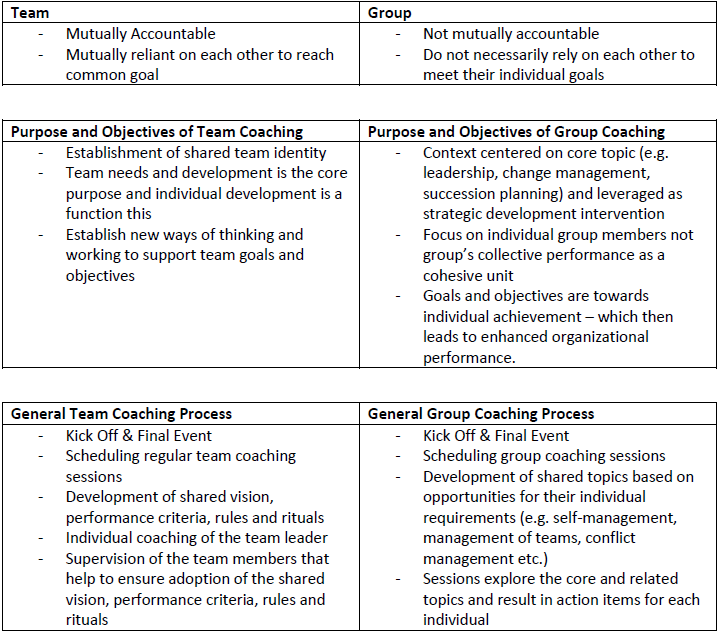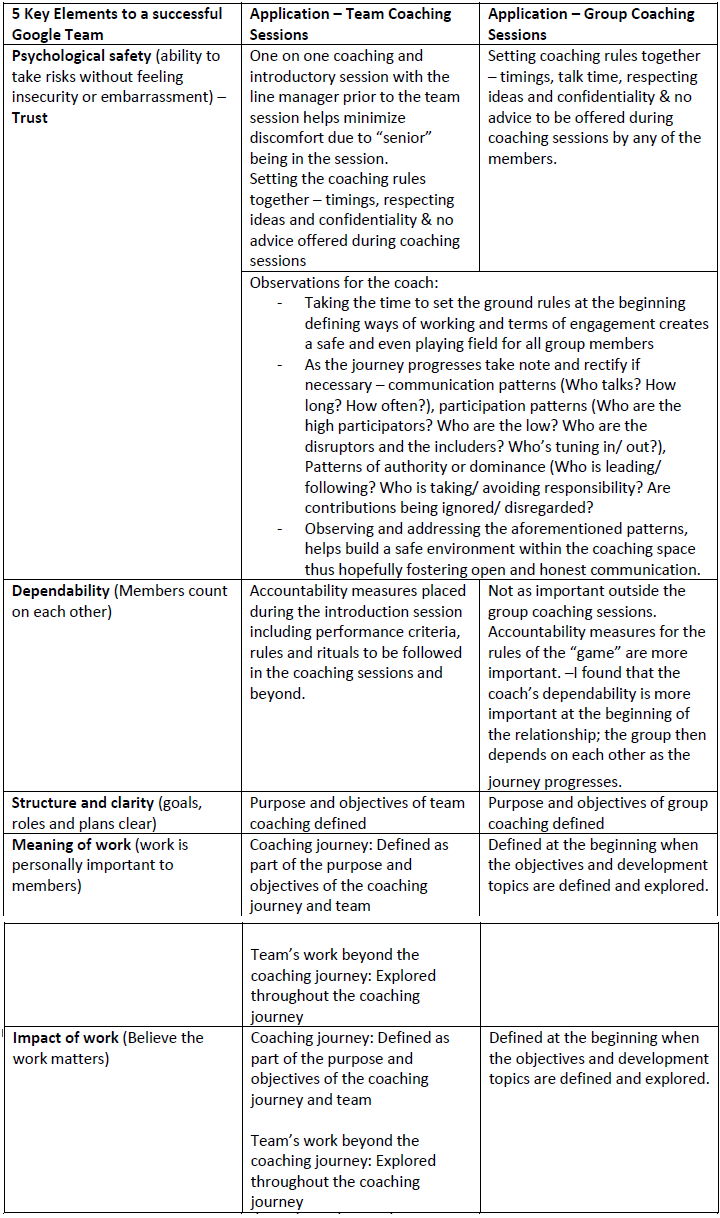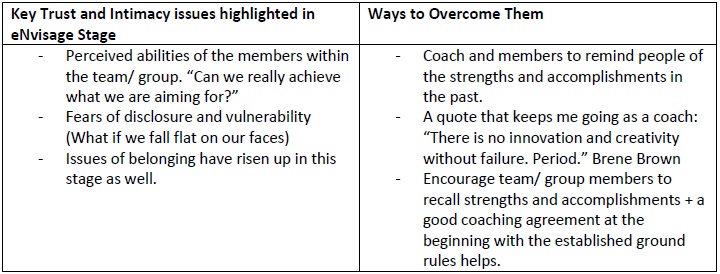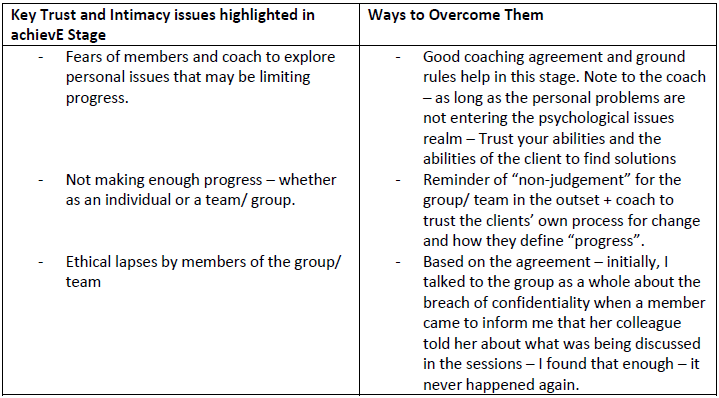
Research Paper By Ghaya Al Barwani
(Corporate Coach, OMAN)
From Obscured Thinking and Communication to Focused Thinking and Communication in Group and Team Coaching
Introduction
I moved into Training and Development after a career in business development when I had my daughter five years ago. Within a year of moving into Training and Development, I started working on my coaching skills when I read the research that it enhances return on investment in training and development. At first, I had the luxury of conducting one to one coaching and with the increased demand and limited resources, namely I am the only coach within the organization, I quickly found myself coaching groups and teams to help them maximize their personal and professional potential.
I found it quite easy to establish trust and intimacy with the individual members of the group; as evidenced by their willingness to open up to me after the session or before the session to explain or work on their individual concerns and issues. The main challenge I faced as a coach was establishing trust and intimacy between the group and/or team members in the coaching sessions. Some of the individual members chose to become circumspect during the session eluding to things, becoming more obscure in the conversation, and hiding details. This lead to a diminishing of the group members trust in opening up and allowed the session to spiral from focused thinking and communication to obscured thinking and communication. During the sessions I used to think that I may have been the cause of the distrust and immediately after the session or just before the next session, I would have individual members of the group contact me to explain the details that were eluded to during the session and not expressed.
This paper is my attempt at self-reflection to understand the group and team dynamics as well as how I worked with the teams and groups that I was coaching to establish trust and intimacy within the group and team throughout the coaching journey. The relevance of this paper goes beyond the reflections of a coach to highlighting the benefits of offering group and team coaching in organizations to develop individual and executive skills on a larger scale; thus allowing leaders to maintain the competitive edge necessary to outperform the competition.
The Group/ Team Coaching Dynamic
The overall objective of coaching is to enable individuals and groups of individuals to broaden, develop and motivate each other to achieve improvement in their performance. The basis of a coaching conversation is one where the coach listens carefully, respond thoughtfully, and allows clients to come up with their own solution that propels them forward towards their stated goals. This is applicable whether the coach is working with an individual, a group or a team.
As determined by the ICF a Group or Team Coaching Session for groups of 15 or fewer counts using the aforementioned guidelines (For those working on chronicling their coaching hours, the actual Coaching time is counted and not multiplied by the number of participants).
The added dimension in the group and team coaching that is not in individual coaching is balancing the team/ group objectives with the objectives of the individuals within the group and balancing the group or team dynamics. Additional elements include:
In addition to the coaching tools and skills available to the coach understanding the team effectiveness models are just as important to understand and manage the group or team dynamics within the coaching journey. I have found the Google Team Model works well with the DANCE coaching model I use when coaching.
Objectives of Team Coaching and Group Coaching
Although used interchangeably by many researchers and articles there is a clear distinction between the two.
Team Coaching deals with
a small group of people with complementary skills who are committed to a common purpose, performance goals and approach for which they are mutually accountable. (Katzenbach and Smith – 1993).
Group Coaching deals with
a number of individuals assembled together or having some unifying relationship. (Merriam-Webster Dictionary)
The table below highlights the key differentiation between teams and groups:

Obscured Thinking and Communication vs Focused Thinking and Communication
What is Obscured Thinking and Communication?
“Obscured” is defined as concealed, kept from being seen and unclear. On an individual basis, this obscurity keeps many people from achieving their goals and aspirations. If a person does not know what they want or don’t know the relevance of what they want or if a person cannot decide what to pool their energy into and focus on in the whirlwind of critical and important things to be done then nothing gets done.
Obscured thinking and communication does not only cover not know the goal or how to get there; it also covers being embroiled in a series of beliefs, thoughts and emotions that hamper progress. The same applies in a group or team setting whether it is caused by just one individual’s obscurity or several members’ obscurity as it creates elements of distrust and psychological insecurity that affects the whole coaching relationship as well as the group or team dynamic.
Obscurity creates delays and doubts as well as highlighting lack of trust whether it is self-trust of members or distrusting the coach and/or team members. Being aware of obscurity within a group and bringing it to focus as an observation is helpful to a coach; as this creates opportunities to allow members to connect with themselves and the group/ team dynamics, breathe it in and work on moving forward away from the discomfort of obscurity, fear of change and trust issues.
What is Focused on Thinking and Communication?
On the other hand, “Focused” is defined directing a great deal of attention, interest, or activity towards a particular aim. It is the cornerstone of execution and achieving the goal. This comes from defining and clearly communicating the goal to the key activities to focus on to achieve the goal.
Focus means defining not only the goal, desired results and benefits of the goal (in terms of how it will look, feel, sound, taste and smell like) but also communicating them, the foreseen obstacles and ways to overcome them as well as the key focused activities to focus on that will lead to achieving the goal.
Maintaining focused thinking and communication within the group or team empowers emotional and logical trust and psychological security. The rest of this paper discusses the tools and methods of honouring and respecting the obscured, fight or flight, reptilian brain in order to move forward towards the to the focused, perceptive and cognitive, human brain through the establishment of trust and intimacy in a group and/or team coaching setting.
Establish Trust and Intimacy with the Client is the third core competency in the ICF Core Competency Framework and is defined:
Ability to create a safe, supportive environment that produces ongoing mutual respect and trust.
It goes on to define the competency as the coach:
- Shows genuine concern for the client’s welfare and future.
- Continuously demonstrates personal integrity, honesty and sincerity.
- Establishes clear agreements and keeps promises.
- Demonstrates respect for the client’s perceptions, learning style, personal being.
- Provides ongoing support for and champions new behaviours and actions, including those involving risk-taking and fear of failure.
- Asks permission to coach client in sensitive, new areas.
I went on to read a blog by Davida Ander on the ICF website in which she explained that Establishing Trust and Intimacy with the Client had four fundamentals from a coach’s perspective:

DANCE Coaching Model
The coaching model helps coaches understand coaching intervention from a systems perspective. It offers the coach the flexibility to move along the client’s agenda while maintaining a framework for the conversation and journey. The DANCE Coaching Model is a reflection of who I am and my perspective as a coach; it draws on my skills, knowledge and experience.
The DANCE Coaching Model is based on the Appreciative Inquiry Business Model, the Strengths-based Positive Coaching Model and Transformational Coaching Model. DANCE is an acronym for Define (direction and purpose), Acknowledge (progress made and the strengths), eNvisage (the big dream, what is to be achieved), Create (the planning phase of the journey) and achievE (the activity and delivery stage of the model).
The rest of this paper will highlight how to move from obscured thinking and communication to focused thinking and communication to establish trust and intimacy in group and team coaching through the DANCE Model. Although discussed in a linear manner, the DANCE steps are far from linear, they are intertwined and interwoven within the session and the journey; sometimes the DANCE may move back and forth between the different steps; the key for the coach and the clients is to be patient and enjoy the rhythm and flow of the DANCE.
Google Team Effectiveness Model
Tuckman’s team and group development of forming, storming, norming, performing and adjourning seems to be the model used by many of the researchers and writers on the group and team coaching. I 6 found that Google’s five keys to a successful google team work well with the DANCE coaching model I use for Group and Team Coaching; the table below highlights the elements and how they are used in Team Coaching and Group Coaching while the rest of the paper touches

Establishing Trust and Intimacy throughout the DANCE Group and Team Coaching Journey
Define – From Obscured to Focused

Define – In group and team coaching:
This is the stage where the focus of the team and/or group is defined for both the coaching journey and beyond. What are the stated objectives of the group or team from the coaching sessions? Is it to reduce turnaround time? Increase sales? Enhance staff engagement? Develop the skills required for the next position within the organization? Generate new leads? Work on productivity issues?
The coaching process is one where the coach is confident that the client (whether an individual, a group or a team) has the solutions to the problems. The coach is there to facilitate the thinking process with the client by listening and asking the relevant question so that the client develops the confidence and skills to implement the solutions that are already with the client.
With individual clients defining the focus is challenging enough, with a group and/or a team of individuals, the process is a little more challenging. Sometimes the organization may have a broad strategy that has been defined for the group and team to follow; sometimes the strategy is unknown to the group and team. Either way translating this strategy or lack of defined strategy into a definable direction and focus is the role of the group or the team I am working with.

Asking clear questions to define the group or team objectives are important. Such as:
Acknowledge – From Obscured to Focused

Acknowledge – In group and team coaching:
Acknowledging individual and collective strengths is critical in the coaching process as it allows the client to build on it. This does not mean developing a Pollyanna mindset and ignoring the challenges or underdeveloped skill sets; just utilizing them in the best way to propel the organization forward and finding solutions to overcome the challenges and underdeveloped skills of the group and team members. This is critical in building trust, intimacy and openness within the coaching process.

Asking clear questions to help acknowledge the group or team strengths and accomplishments are important. If they are reluctant to share experiences within the current organization or setting they can use past experiences in other organizations and settings to answer questions such as:
- What can you stop doing?
- To what extent is this area really relevant for you right now?
- Who else can handle these areas of development so that you can spend less time and energy on them?
- What would be “good enough”?
eNvisage – From Obscure to Focused

eNvisage – In group and team coaching:
eNvisage is the point where the defined direction is given a specific definition and target. This is critical in the team coaching process as it gives the team a collective focus on the actual deliverables. With group coaching the topics being discussed help the individuals eNvisage the results they will achieve to deliver the organizational objectives they agreed to work on in the Define stage of coaching.

Some sample questions that have been helpful are:
eNvisage is where the SMART goals and objectives are defined whereas Define is the overall direction is clarified. Trust and intimacy are critical in this stage to build consensus within the group or team. When distrust creeps up it usually is highlighted in this stage; this is when the coach, as a facilitator, having helped the group and team define the ground rules of confidentiality and non-judgement reminds them of these critical cornerstones for progressing through this path.
Create – From Obscure to Focused:

Create – In group and team coaching:
This is where the action steps are defined; with teams, I find that the 4DX model of the key lead measures to be taken is defined. In organizational group coaching, I find it a useful tool as well. How progress will be tracked and celebrated is also defined in this stage.

Useful questions to ask could be:
- Designed a scoreboard of target activities versus actual
- Maintained a chain in their calendar to help them keep track of activities and progress.
- An accountability partner(s)? Who will that be and what will you ask them to do to help you on your journey?
- How often will you review your progress?
achievE – From Obscure to Focused

achievE – In group and team coaching:
achievE is what propels the sessions from general chatter to coaching sessions that deliver results. This is when accountability and efficacy are built and delivery of results propels the team and group dynamic into trusting themselves, the process and each other.

Possible questions to ask:
DANCE – From Obscure to Focused – What next?
The journey is a DANCE with the group or team and coach moving from obscurity to focus in every session and throughout the journey. At every session and at every turn the coach will ask the group/ team to define the focus of the session and what is really important for the next step of the journey.
Once the initial target is achieved the group/team can be invited to continue the DANCE with a new focused wildly important goal that will help make the greatest impact going forward. They start focusing on the next major project they want to achieve.
Key Learnings on Establishing Trust and Intimacy in Group and Team Coaching – As Coach
The process of coaching groups and teams was one I started out of necessity due to the limited time I had as an individual to coach within an organization. My self-reflection primarily demonstrated that trust and intimacy start with me – the coach.
Trusting my competencies and myself as a coach were core. My ability to deal with strong emotions and not knowing the reactions of the group and team members while remaining empathetic and compassionate with all the members throughout the journey was severely tested and worked on during the journey. My personal opinions, judgements and control issues were things that I learned to bypass in the process to allow my collective client the opportunity to express themselves and be open with each other and me. This allowed respect for the clients’ views, ideas and agenda in all honesty thus delivering the expected results and exceeding them in some cases. By overcoming my distrust of working with multiple individuals at the same time allowed my clients to overcome their resistance to the group and team coaching.
Trusting the coaching process and the guidelines set by the group and team was the second important learning. This allowed for an equal partnership in the coaching process. Some of the most important and thought to provoke questions were brought forward by members of the coaching group and team which propelled the progress of all those involved, including me as an individual and coach. This released me from having to do all the work in the coaching journey and allowed the DANCE to flow with ease and grace.
Trusting that the coaching journey is a collective responsibility. By releasing myself from the obligation of being responsible for the trust and intimacy developed and established within the group or team members, I was free to enjoy the process and allow them to develop it in their own pace and time. I stopped giving advice and just heard them individually and collectively allowing them to find their self-trust and self-confidence as individuals and in their collective strengths.
The table below highlights the key learnings of the key group and team coaching journeys I was privileged to be a part of:

Bibliography:
Edited by Roderick M. Kramer & Karen S Cook – Trust and Distrust In Organizations: Dilemmas and Approaches (2007), Russel Sage Foundation
Beverly Patwell – Why Coaching Must Play an Integral Role in Leading and Managing in Today’s Workplace (May 2013) – Queen’s University IRC
Scoltes, Joiner, Streibel – The Team Handbook, 3rd Edition, Oriel
Vijay Verma – Managing the Project Team, PMI
Wikipedia – Team Building (2018)
Rick Lepsinger – How to Build Trust In a Team: 4 Key Tactics, On Point Consulting
Michael C Mack – How to Help Group Members Embrace Intimacy, Moody.Edu/ Changelives
Lisa McQuerrey (Updated 2018) – The Importance of Trust Within a Team, Chron.com
Reina D, Reina M, Hudnut D (2017) – Why Trust is Critical to Team Success – Research Report, Center for Creative Leadership
Kukhnavets (2018) – What Team Effectiveness Model Will Make a Team Perform Better, Hygger Blog
Riter – 8 Models of Team Effectiveness
Dr Sunil Gupta – Sweet & Sour; Relationships Lose Their Flavour (2016), Muscat Printing Press
Wendy Hirsch – Trust: Does it impact team performance… or not?, Scienceforwork.com
Covey, Merrill – Speed of Trust (2008), Simon and Schuster
McChesney, Covey, Huling – The 4 Disciplines of Execution (2012), Free Press
Harvard Business Review Articles:
Daniel Dworking – Do You Trust Your Team? (2018)
Lt Colonel Diane Ryan – 6 Questions to Help You Build Trust on Your Team (2009)
Brene Brown – Daring Greatly (2013), Penguin UK
Brene Brown – Dare to Lead (2018), Penguin Random House
International Coaching Federation
ICF Core Competencies
PCC Core Competency Markers
ICF Core Competencies Rating Levels
Ro Gorell – Coaching People in Groups (2013), ICF
Davida Ander – From the Toolbox: Trust and Intimacy Explained (2014), ICF
ICA Coach Training Modules:
Foundation Coach: The ICF Competencies
Foundation Coach: Coaching Models
Coach Skills: Creating Trust
Power Tools: Trust vs Fraud
Power Tools: Trust vs Doubt
Power Tools: Respect vs Invalidation
Frameworks & Models: Appreciative Inquiry
ICA Forum Papers:
Merci Miglino – Group Coaching Model (2018)
Katerina Kanelidou – Trust and Intimacy; Coaching Survey Report (2018)
Joanna del Pino – Research Paper: The ICF Competency: Coaching Presence (2018)
Dr Nicole Scott – Research Paper: Application of the ICF Competencies in the Team Coaching and Group Coaching Context
Maria Spanou – Research Paper: TRUST – Building trust through conversations & behaviour